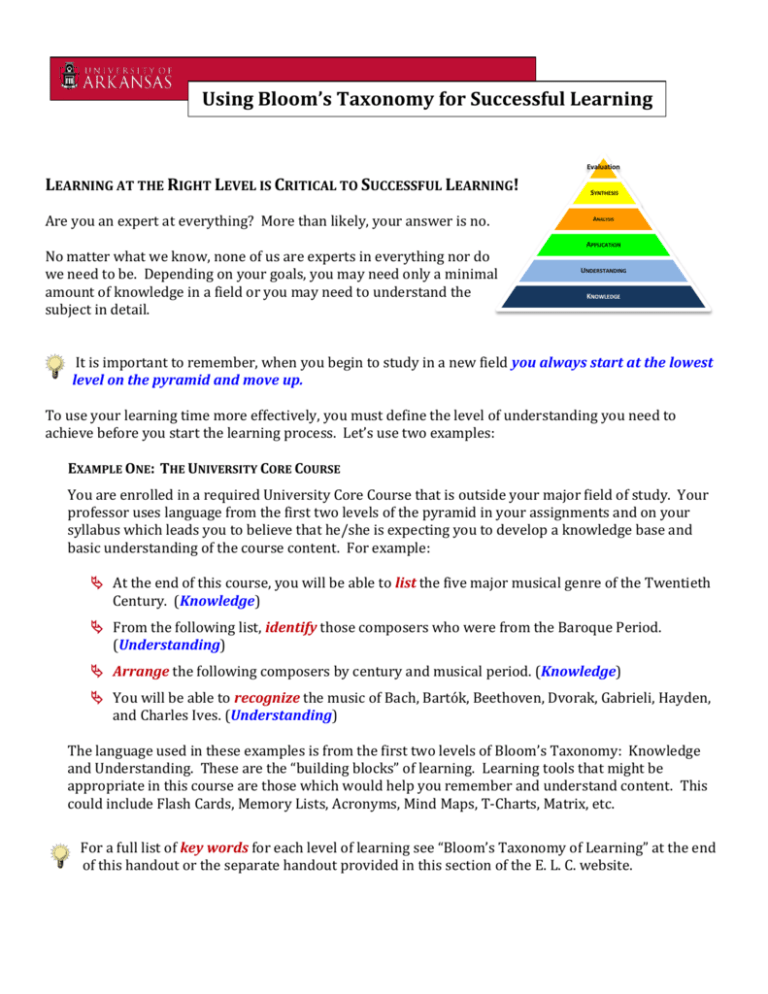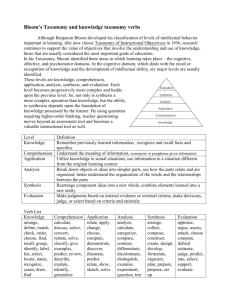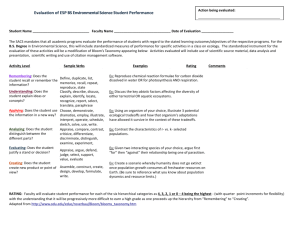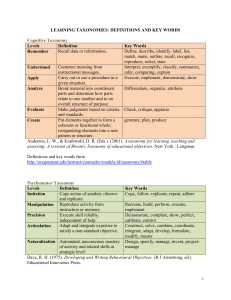Using Bloom's Taxonomy for Successful Learning
advertisement

Using Bloom’s Taxonomy for Successful Learning Evaluation LEARNING AT THE RIGHT LEVEL IS CRITICAL TO SUCCESSFUL LEARNING! Are you an expert at everything? More than likely, your answer is no. No matter what we know, none of us are experts in everything nor do we need to be. Depending on your goals, you may need only a minimal amount of knowledge in a field or you may need to understand the subject in detail. SYNTHESIS ANALYSIS APPLICATION UNDERSTANDING KNOWLEDGE It is important to remember, when you begin to study in a new field you always start at the lowest level on the pyramid and move up. To use your learning time more effectively, you must define the level of understanding you need to achieve before you start the learning process. Let’s use two examples: EXAMPLE ONE: THE UNIVERSITY CORE COURSE You are enrolled in a required University Core Course that is outside your major field of study. Your professor uses language from the first two levels of the pyramid in your assignments and on your syllabus which leads you to believe that he/she is expecting you to develop a knowledge base and basic understanding of the course content. For example: At the end of this course, you will be able to list the five major musical genre of the Twentieth Century. (Knowledge) From the following list, identify those composers who were from the Baroque Period. (Understanding) Arrange the following composers by century and musical period. (Knowledge) You will be able to recognize the music of Bach, Bartók, Beethoven, Dvorak, Gabrieli, Hayden, and Charles Ives. (Understanding) The language used in these examples is from the first two levels of Bloom’s Taxonomy: Knowledge and Understanding. These are the “building blocks” of learning. Learning tools that might be appropriate in this course are those which would help you remember and understand content. This could include Flash Cards, Memory Lists, Acronyms, Mind Maps, T-Charts, Matrix, etc. For a full list of key words for each level of learning see “Bloom’s Taxonomy of Learning” at the end of this handout or the separate handout provided in this section of the E. L. C. website. EXAMPLE TWO: THE MAJOR COURSE You are a sophomore and enrolled in a 3000 Level Course in your major. In his/her syllabus and exams, your professor uses language from the first through fifth levels of the pyramid: This course is an introduction to electronic systems and signal processing. You will be able to recognize the internal components and operating systems of each type of system. (Knowledge) After completing this course, students should be able to calculate the response of zero-state and zero-input systems. (Analysis) Describe the properties of Z and Fourier Transforms. (Understanding) Design and calculate the BW for filters, in the context of a larger system. (Analysis & Synthesis) Choose the appropriate filter for a given system. (Application) Obviously, the tools for remembering and understanding have a place here, but their use will be somewhat limited. This course now requires that you begin to apply, analyze and evaluate information based on past learning. Tools that might be helpful for these higher levels of learning include Word Cards (Technical Terms), Problem Cards, Self-Created Test Banks, Self-Created Lab or Project Notebooks, etc. The benefit of Bloom’s Taxonomy is that it helps you identify where you are and where your professor expects you to be on the pyramid for a particular class or subject. Once you know this, you can develop learning strategies that are most appropriate, effective, and efficient for your class. Start where you are in terms of knowledge in a subject and to adjust your learning strategies as you move up the pyramid to more complex and demanding learning. Go to the “Bloom’s Taxonomy of Learning” Handout for those words which will help you identify what level(s) of learning your professor expects from you in his/her class. These synonyms might help you remember Bloom’s Levels of Learning: Evaluation Creating Synthesis Evaluating Analysis Analyzing Application Applying Understanding Understanding Knowledge Remembering Anderson, L. W. & Krathwohl, D. R. (Eds.) 2001. A Taxonomy for Learning, Teaching , and Assessing: A Revision of Bloom’s Taxonomy of Educational Objectives. New York: Addison Wesley Longman Bloom, B. S. (Ed.), Engelhart, M. D., Furst, E. J., Hill, W. H., & Krathwohl, D. R. 1956. Taxonomy of Educational Objectives: Handbook I: Cognitive Domain. New York: David McKay Bloom’s Taxonomy of Learning EVALUATION SYNTHESIS ANALYSIS APPLICATION UNDERSTANDING KNOWLEDGE EVALUATION = appraise, argue, assess, attach, choose, compare, defend, estimate, judge, justify, rate, recommend, select, support, value, evaluate SYNTHESIS = arrange, assemble, collect, compose, construct, create, design, develop, formulate, hypothesize, invent, monitor, organize, plan, prepare, propose, setup, test ANALYSIS = analyze, appraise, calculate, categorize, compare, contrast, criticize, differentiate, discriminate, distinguish, examine, experiment, integrate, outline, question, separate, test APPLICATION = apply, choose, construct, demonstrate, dramatize, employ, illustrate, interpret, operate, practice, schedule, sketch, solve, use, write UNDERSTANDING = clarify, classify, describe, discuss, explain, express, identify, illustrate indicate, locate, paraphrase, recognize, report, restate, review, select, summarize, translate KNOWLEDGE = arrange, define, duplicate, identify, label, list, memorize, name, order, recognize, relate, recall, repeat, reproduce, retrieve, state, write









